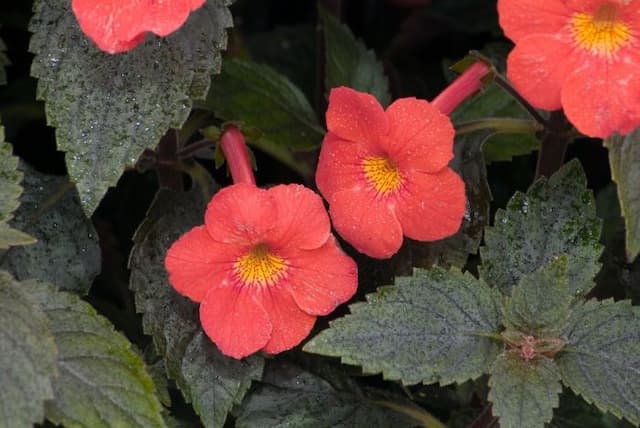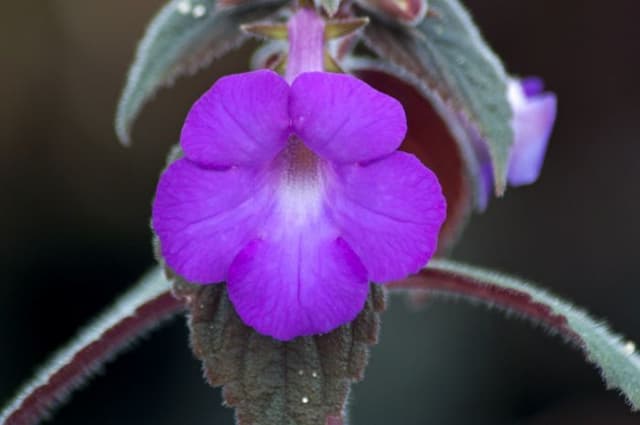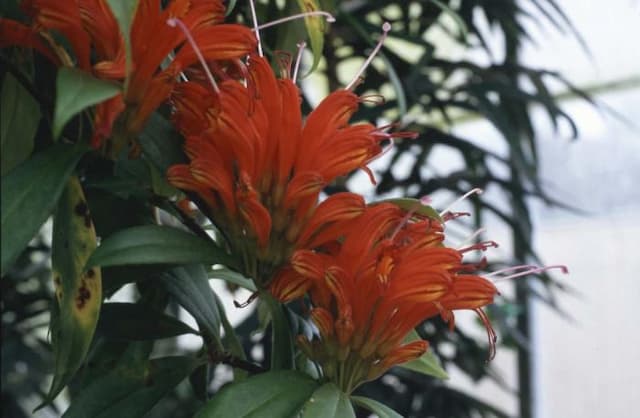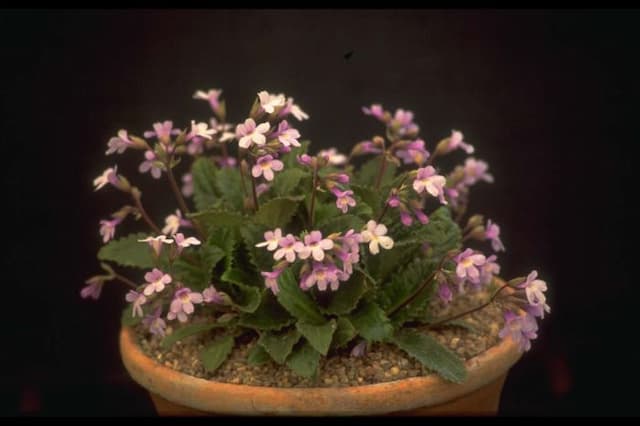Cape Primrose Streptocarpus 'Laura'

ABOUT
The Streptocarpus 'Laura', commonly known as Cape Primrose, showcases a rosette arrangement of its leaves that are long and textured, with a soft and velvety feel. The foliage is a deep green, often with lighter green or silvery veins that create a beautiful contrast. Its blooms are quite striking, with a trumpet-like shape that is characteristic of the Cape Primrose. The flowers of 'Laura' exhibit a lovely shade of purple with intricate patterns, often with white throats or centers and occasionally with speckles or streaks enhancing their appearance. These blossoms are born on slender stems that elegantly rise above the foliage, creating a delightful display of color. The overall impression of Streptocarpus 'Laura' is of a lush and vibrant plant with attractive foliage and eye-catching flowers that add elegance and a touch of the exotic to any indoor setting.
About this plant
 Names
NamesFamily
Gesneriaceae
Synonyms
Cape Primrose, African Violet Cousin
Common names
Streptocarpus 'Laura'
 Toxicity
ToxicityTo humans
The Cape primrose (Streptocarpus 'Laura') is not known to be toxic to humans. Therefore, if ingested, it is unlikely to cause poisoning or severe adverse effects. However, it's always best to avoid eating ornamental plants as a general safety practice.
To pets
The Cape primrose (Streptocarpus 'Laura') is generally considered non-toxic to pets, including cats and dogs. Ingestion of this plant should not result in poisoning or serious health issues. However, as with any non-food item, ingestion of large amounts could potentially cause mild gastrointestinal upset.
 Characteristics
CharacteristicsLife cycle
Perennials
Foliage type
Evergreen
Color of leaves
Green
Flower color
Purple
Height
1 foot (30 cm)
Spread
1 foot (30 cm)
Plant type
Herb
Hardiness zones
10
Native area
Africa
Benefits
 General Benefits
General Benefits- Aesthetic Appeal: Offers vibrant flowers and decorative foliage, enhancing indoor and outdoor spaces.
- Easy to Care: Able to thrive with minimal care, suitable for beginner gardeners or those with limited time.
- Long Blooming Period: Flowers throughout the year, providing continual enjoyment and color.
- Compact Size: Ideal for small spaces, windowsills, or areas with limited room.
- Variety of Colors: Comes in a wide range of flower colors, allowing for personalized decor choices.
- Propagation Ease: Can be easily propagated from leaf cuttings, offering a cost-effective way to increase your collection.
 Medical Properties
Medical PropertiesThis plant is not used for medical purposes.
 Air-purifying Qualities
Air-purifying QualitiesThis plant is not specifically known for air purifying qualities.
 Other Uses
Other Uses- Photography subject: Due to its vibrant colors and attractive foliage, Streptocarpus 'Laura' can be utilized by photographers seeking to capture the beauty of unique florals in still life photography.
- Botanical studies: Botany enthusiasts and students can use this plant to study the growth patterns and genetic traits of the Gesneriaceae family.
- Art inspiration: Artists may draw inspiration from the distinct shape and colors of the Streptocarpus 'Laura' for various art projects, including painting and textile designs.
- Edible garnish: Although not widely known for its edibility, the flowers of Streptocarpus 'Laura' can be used as a decorative, non-toxic garnish for culinary dishes.
- Living gifts: With its long-lasting blooms, a potted Streptocarpus 'Laura' can be given as a living gift that symbolizes enduring friendship or love.
- Teaching tool: Educators can use this plant to teach students about pollination and the reproductive cycle of flowering plants.
- Wedding décor: The elegant blooms of Streptocarpus 'Laura' could be incorporated into wedding bouquets or table arrangements.
- Horticultural therapy: Working with plants like Streptocarpus 'Laura' can be soothing and therapeutic, helping individuals reduce stress through the nurturing of living things.
- Flower pressing: The blooms can be pressed and preserved as a hobby or for creating handcrafted items like bookmarks and cards.
- Color palette inspiration: The diverse shades of Streptocarpus 'Laura' blossoms can inspire color palettes for interior design and fashion.
Interesting Facts
 Feng Shui
Feng ShuiThe Cape Primrose is not used in Feng Shui practice.
 Zodiac Sign Compitability
Zodiac Sign CompitabilityThe Cape Primrose is not used in astrology practice.
 Plant Symbolism
Plant Symbolism- Resilience: Streptocarpus, also known as Cape Primrose, often symbolizes resilience because it can thrive with minimal care and rebound from neglect.
- Enduring Love: The long-lasting flowers of the Cape Primrose can represent enduring love, suggesting a relationship that withstands challenges over time.
- Hope: With its bright and uplifting flowers, the Cape Primrose can be seen as a symbol of hope, bringing a sense of optimism to those who grow it.
- Versatility: The Cape Primrose is adaptable to various indoor environments, which can symbolize versatility and the ability to thrive in different situations.
 Water
WaterFor Cape Primrose, which is the most common common name for Streptocarpus 'Laura', water the plant when the top inch of soil feels dry to the touch. This often equates to once per week, but frequency can vary based on environmental factors such as humidity and temperature. Use room temperature water and gently pour it around the base of the plant until water starts to drain from the bottom of the pot. Ensure that the plant is never sitting in water, as this can lead to root rot. It's usually sufficient to provide around 8-16 ounces of water each time, adjusting the amount as the plant grows or as seasonal conditions change.
 Light
LightCape Primrose thrives in bright, indirect light. Place the plant near a north or east-facing window where it can receive plenty of light without being exposed to the harsh rays of the direct sun. Avoid placing it in full sun, which can scorch the leaves and lead to wilting. A spot that provides diffused light, such as through a sheer curtain, is ideal.
 Temperature
TemperatureCape Primrose prefers consistent temperatures between 60 and 75 degrees Fahrenheit. It can survive temporarily outside of this range, but exposure to temperatures below 50 degrees Fahrenheit or above 80 degrees Fahrenheit can cause stress to the plant. The ideal temperature range provides a comfortable environment for robust growth without threatening the plant with cold damage or excessive heat.
 Pruning
PruningPruning Cape Primrose is crucial for encouraging bushier growth and more blooms. Prune back leggy stems and remove any spent flowers to stimulate new growth. The best time for pruning is immediately after a bloom cycle ends, typically in late summer or early fall. It's often recommended to prune annually, but this can vary depending on the plant's growth pattern and appearance.
 Cleaning
CleaningAs needed
 Soil
SoilThe best soil mix for Cape Primrose (Streptocarpus 'Laura') is a lightweight, well-draining potting mix, ideally with added perlite or vermiculite to enhance aeration. The pH should be slightly acidic to neutral, ranging from 6.0 to 7.0, to support optimal growth.
 Repotting
RepottingCape Primrose should be repotted annually or when it outgrows its current pot. Spring is the best time to repot to minimize stress and allow for vigorous growth in the growing season.
 Humidity & Misting
Humidity & MistingCape Primrose thrives in moderate to high humidity levels, between 50% and 70%, which can often be achieved in a typical home environment.
 Suitable locations
Suitable locationsIndoor
Place in bright, indirect light and keep soil lightly moist.
Outdoor
Shelter from strong sun; water when topsoil feels dry.
Hardiness zone
10-11 USDA
 Life cycle
Life cycleCape Primrose 'Laura' begins its life cycle as a seed, which upon germination produces a small rosette of leaves. The rosette grows and matures, developing a robust root system. After a period of vegetative growth, which can vary from a few months to over a year depending on conditions, it begins to produce flower stalks, with blooms typically appearing in a range of colors including shades of pink, purple, and white. Post pollination, if successful, these flowers produce seed pods that ripen and eventually burst, dispersing seeds for the next generation. Throughout its life, Cape Primrose 'Laura' may also be propagated vegetatively via leaf cuttings, where a piece of leaf inserted into the soil can develop roots and grow into a new plant. This plant may go through multiple flowering cycles before eventually senescing, though with proper care it can live and bloom for several years.
 Propogation
PropogationPropogation time
Spring to Summer
Streptocarpus 'Laura', commonly known as the Cape Primrose, can be propagated effectively through leaf cuttings. The best time to do this is during the spring or early summer when the plant is actively growing. To propagate, a healthy leaf is selected and cut across the width into sections, each section with at least one vein. These cuttings are then placed on top of a moist potting mix, ensuring that the vein touches the soil. In a warm environment with indirect light, the cutting will develop roots and eventually form small plantlets at the cut edge. These can be potted up individually once they have formed a small rosette of leaves and have enough root structure to sustain them, usually within a few weeks to a couple of months.









